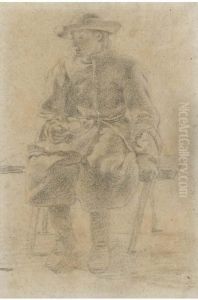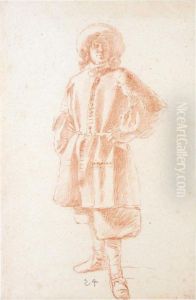Ter Moses Borch Paintings
Ter Moses Borch, also known as Ter Borch or Gerard ter Borch, was a Dutch Golden Age painter, who was born in December 1617 in Zwolle, Netherlands, and died on April 8, 1681, in Deventer. He is best known for his detailed and delicate genre scenes as well as his fine portraits. Ter Borch came from an artistic family: his father, Gerard ter Borch the Elder, was a painter and draughtsman, and his stepmother and his half-brother were also artists.
Ter Borch’s early life was marked by travel and artistic learning. He spent his formative years in various cities, including Amsterdam, where he was a pupil of his father, and Haarlem, where he studied under Pieter de Molijn, an artist known for his landscapes and genre scenes. He traveled extensively throughout Europe, including England, Italy, Spain, and Germany, which exposed him to a wide range of artistic styles and techniques. During his travels, he also had the opportunity to study under other prominent artists such as Pieter van Laer in Rome, who influenced Ter Borch's own approach to genre scenes.
Ter Borch was not only a talented painter but also a skilled draftsman. His drawings are praised for their precision and clarity, demonstrating his keen observation of human figures and their surroundings. His genre paintings are often intimate, depicting scenes of everyday life with an emphasis on the emotional and social interactions of the figures. He is particularly renowned for his ability to render textures and materials, such as satin and velvet, with remarkable realism. One of his most famous works is 'The Gallant Conversation,' also known as 'Paternal Admonition,' which showcases his mastery in capturing the subtleties of human expression and the detailed rendering of luxurious fabrics.
In the 1650s, Ter Borch settled in Deventer, where he became a burgher and later served as a municipal official. While he continued to paint, his later works were mostly portraits. His portraits are known for their elegance and the dignified portrayal of his subjects. Ter Borch's refined technique and attention to detail made him one of the leading portraitists of his time.
Ter Borch's influence on Dutch painting was significant, and his work was highly regarded by his contemporaries. His half-brother Gesina ter Borch was also an artist, and she worked with him on several occasions. Ter Borch's legacy continued through his pupils, including his younger brother Moses ter Borch and Caspar Netscher, who both became accomplished artists in their own right. Ter Borch’s art is held in high esteem and can be found in major museums around the world, ensuring his place as one of the prominent figures of the Dutch Golden Age.

